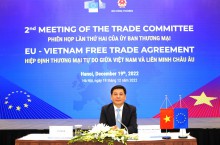The News
Characteristics and market development trends for some typical products in Poland
Poland is currently Vietnam's number one customer in Eastern Europe, the exchange turnover of goods in recent years has increased quite quickly and mainly Vietnam has a trade surplus. Vietnam is Poland's 7th largest trading partner outside the European Union (EU). According to statistics of the General Department of Vietnam Customs, in 2021, the total import and export turnover of the two countries reached nearly 2.6 billion USD, up 21.8% compared to 2020 (2.1 billion USD) of which Vietnam has a trade surplus of more than 1.6 billion USD.
Poland is currently Vietnam's number one customer in Eastern Europe, the exchange turnover of goods in recent years has increased quite quickly and mainly Vietnam has a trade surplus. Vietnam is Poland's 7th largest trading partner outside the European Union (EU). According to statistics of the General Department of Vietnam Customs, in 2021, the total import and export turnover of the two countries reached nearly 2.6 billion USD, up 21.8% compared to 2020 (2.1 billion USD) of which Vietnam has a trade surplus of more than 1.6 billion USD.
- Polish market characteristics
Poland's economy grew mainly due to exports to EU countries and Russia. Poland has pursued a policy of economic liberalization and stands out as a success story among transitioning economies. It is the only country in the European Union that maintained a positive GDP growth rate during the 2008-2009 recession. In 2014-1017, the Polish economy grew relatively well, GDP in 2015 was 3.8%, falling to 2.9% in 2016 and then rising to 4.6% in 2017. From 2018 to 2020, Poland maintained its growth.
Polish exports are mainly machinery, leather goods, food, frozen fruits, furniture, coal, machinery, ceramics, ships. The main imports are oil, automobiles, pharmaceuticals, electronics.

Poland faces many challenges, which include addressing some of the remaining shortcomings of railway and road infrastructure, business environment, labor, commercial court system, bureaucracy, and tax system, especially for entrepreneurs. Added to this are long-term challenges including diversifying Poland's energy sources and supplies, increasing investment in innovation, research and development.
The Polish economy has many advantages: efficient use of resources from European Structural Funds, a solid banking system, strong domestic demand and appropriate fiscal policy. The government's priorities are to find a balance between public finance reform measures and efforts to stimulate economic growth. As a result, in 2014, Poland cut its budget targets and stimulated economic growth.
In the future, the Polish government wants to attract investors in the field of new technologies and increase spending on Research and Development (R&D). Poland's economic performance could improve in the long run if the country addresses some of the remaining shortcomings in its roads and railway infrastructure and business environment.
2. Bilateral trade relations between Vietnam and Poland
Poland is currently Vietnam's number one customer in Eastern Europe, the exchange turnover of goods in recent years has increased quite quickly and mainly Vietnam has a trade surplus. Vietnam is Poland's 7th largest trading partner outside the European Union (EU).
According to statistics of the General Department of Vietnam Customs, in 2021, the total import and export turnover of the two countries reached nearly 2.6 billion USD, up 21.8% compared to 2020 (2.1 billion USD) of which Vietnam has a trade surplus of more than 1.6 billion USD.
Even though both developing the agriculture sector, Vietnam and Poland do not compete directly but effectively support each other. With Poland’s many years of experience in developing high-tech agriculture, Vietnam can learn from experiences from Poland to improve the former’s agricultural technology including investment in specialized agriculture, fertilizers and machinery.
In addition, the implementation of the EU-Vietnam Free Trade Agreement will create conditions for Vietnam and Poland to promote trade cooperation in the coming time.
Table of export turnover between Vietnam and Poland - Units of 1,000 USD
(Source General Department of Customs)
| 2016 | 2017 | 2018 | 2019 | 2020 | 2021 |
VN Export | 597.612 | 775.748 | 1.334.961 | 1.500.828 | 1.774.043 | 2.067.063 |
VN Import | 191.745 | 230.671 | 266.614 | 298.928 | 340.614 | 509.307 |
Import export turnover | 789.357 | 1.006.419 | 1.601.575 | 1.799.756 | 2.114.658 | 2.576.370 |
3. Polish market development trends
Commodities accounting for a large proportion of Vietnam's commodity structure exported to the Polish market include garments, seafood, agricultural products such as cereals, coffee or shoes of all kinds. In particular, Poland is also in need of importing other commodities such as rice, agricultural products (rice, citrus fruits, bananas, tobacco, coconut oil ...), cooking oil, organic food, healthy products from Vietnam.
Poland, on the other hand, has strengths in pharmaceuticals, dairy products, animal feed or cosmetics. These are products that Vietnam has a large import demand.
Vietnamese exporters should also note that the Polish market is characterized by a wide population dispersion with 25% of Poles living in rural areas and urban people mainly live in the center, the capitals of the provinces and regions. Urban consumers often have greater purchasing power than rural ones.
In addition, a personal relationship with customers is an important factor in the purchasing decision of the Polish partner, and negotiations are usually through face-to-face meetings. Therefore, a successful distribution of goods in Poland often requires the presence of agents, distributors or representative offices in Poland.
Although English is already quite popular in urban areas of Poland, communicating in Polish is still encouraged and facilitated in negotiations with Polish businessmen.



